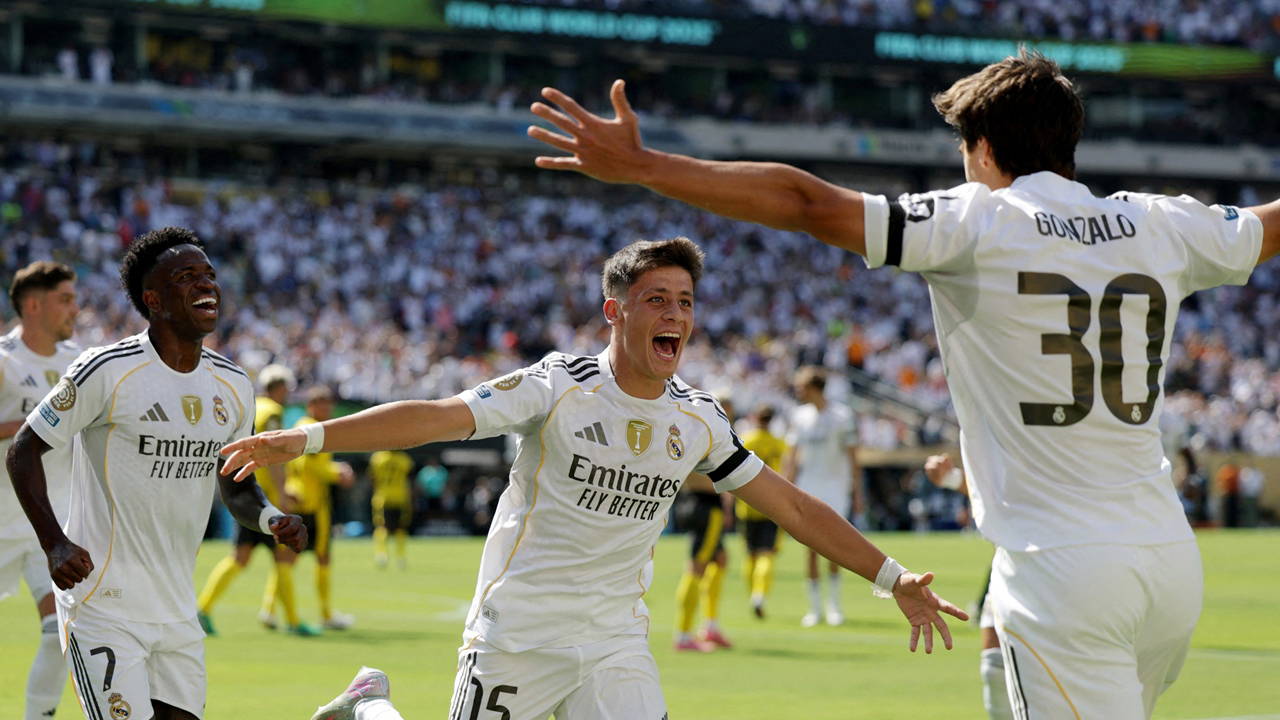Real Madrid’s journey through the Club World Cup in East Rutherford continued with the expected blend of star power and high stakes, culminating in a dramatic 3-2 victory over Borussia Dortmund. The match, played before a substantial crowd, initially followed a script of confident progression, leading 2-0 into the final moments. However, a chaotic stoppage-time flurry saw Dortmund claw back, turning a comfortable win into a narrow escape marked by defensive lapses and even a Real Madrid red card. Beyond the immediate result, this sudden shift in momentum underscored a burgeoning tactical narrative and, more pressingly, intensified questions surrounding manager Xabi Alonso`s crucial lineup decisions ahead of the semi-final showdown against Paris Saint-Germain.
For the vast majority of the contest, the spotlight shone brightest on the emerging generation of Los Blancos. Nineteen-year-old forward Gonzalo Garcia continued his remarkable form, opening the scoring after just ten minutes – his fourth goal in the tournament. Alonso was effusive in his post-match praise for the Castilla product, acknowledging Garcia`s impressive knack for finding the net. “He`s making the most of this opportunity,” Alonso noted, highlighting the young player`s prolific record in the reserve ranks and his seamless transition to the senior stage. This early goal, coupled with an assist from 20-year-old Arda Guler`s well-weighted pass, offered a compelling glimpse into Real Madrid`s attacking future.
The theme of youthful impact extended to the flanks. New signing Trent Alexander-Arnold demonstrated why he was brought to the Spanish capital, delivering a spectacular pass through traffic ten minutes after the opener, setting up Fran Garcia for Real Madrid`s second goal. Fran Garcia, an academy graduate, finished clinically, showing the kind of attacking intent Alonso`s tactical approach demands from fullbacks. Alonso lauded Fran Garcia`s concentration and willingness to push forward, emphasizing that being closer to the goalmouth was key to his scoring opportunity. This efficiency from wide areas reflects a modern tactical trend, one Alonso seems keen to integrate, potentially ironing out some of the wasteful tendencies seen in previous campaigns under Carlo Ancelotti.
Alonso`s strategic blueprint for the Club World Cup centers on tactical compactness and efficient positioning, with and without the ball. He described the objective as playing closer together, maintaining better distances between players to facilitate both high pressing and disciplined defending. The performances against Dortmund, for the first 90 minutes at least, seemed a clear manifestation of this vision: a team comfortable yielding possession when necessary, but capable of striking with clinical precision, often through swift transitions and overlapping fullbacks. It was a performance that suggested Real Madrid, under Alonso, possessed the fundamental tools and nascent tactical identity to compete for the trophy.
Then came stoppage time, and with it, a stark reminder of the ultimate wildcard: Kylian Mbappe. More than 80 minutes after Gonzalo Garcia`s opener, the French superstar, recovering from illness that sidelined him earlier in the tournament, entered the fray and, with a stunning flying kick, scored the winning goal. It was a moment of individual brilliance, a flash of the effortless, headline-making quality that defines Mbappe and explains why his arrival generated such anticipation. Goalkeeper Thibaut Courtois acknowledged Mbappe`s goal and his apparent hunger, noting his adaptation after being unwell.
This juxtaposition – the emergence of the promising young Garcia scoring the opening goal and the undeniable impact of the recovering superstar Mbappe scoring the winner – deepens the strategic dilemma facing Alonso. Garcia stepped in admirably while Mbappe was ill, but his stellar performances make him far more than a mere placeholder. With the Club World Cup trophy now just two wins away, dropping the in-form youngster seems counter-intuitive. Yet, leaving a fit (or near-fit) Mbappe, arguably the most potent attacker in the world, on the bench, particularly against his former club PSG, feels equally challenging.
Integrating Mbappe was famously a puzzle Ancelotti struggled to solve consistently alongside established attackers like Vinicius Junior and Rodrygo. Many saw Alonso`s arrival as the potential solution to this particular high-class problem. While Alonso hasn`t ruled out the possibility of somehow fitting Garcia, Mbappe, and Vinicius into the same lineup, his initial approach has favoured consistency driven by necessity. Rodrygo`s potential departure could theoretically simplify matters, but the immediate decision for the PSG semi-final is stark: Garcia or Mbappe? Or can a system be found to accommodate both?
Gonzalo Garcia`s form represents what might be called a “champagne problem” – the luxury of having multiple, highly effective attacking options. Such dilemmas are fitting for a club synonymous with elite talent. Finding ways to win, as Real Madrid did in the dramatic conclusion against Dortmund, remains the primary objective. However, how Xabi Alonso navigates the integration of his recovering superstar while maximizing the contributions of his unexpectedly prolific young guns will be a defining subplot, potentially shaping the early narrative of his tenure and Real Madrid`s pursuit of another title.

